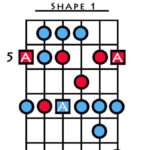The PRS SE series has long been lauded for bringing Paul Reed Smith’s renowned design and quality to a more accessible price point. Among these, the PRS SE Custom 24 has been a consistent favorite. However, the introduction of the Prs Se Standard 24 Guitar, positioned at an even more budget-friendly price, naturally raises questions. Can this more affordable model deliver the PRS experience, and how does it stack up against its esteemed sibling, the SE Custom 24? I was eager to get my hands on the SE Standard 24 to explore these very questions.
The Positives: Where the SE Standard 24 Shines
First impressions matter, and the PRS SE Standard 24 doesn’t disappoint in the looks department. While it might not boast the visually striking figured maple top of the SE Custom 24, it still presents a handsome aesthetic. The model I evaluated exhibited excellent fit and finish, free from any noticeable flaws. Aesthetically, it holds its own as a visually appealing instrument.
Moving to sound, while the pickups in the SE Standard 24 might not be identical to those found in the SE Custom series, they are surprisingly capable. To my ears, they offer a slightly more aggressive and raw tonal character, which some players might actually prefer. This isn’t to say they are lacking in quality; rather, they possess a distinct voice that leans towards a more gnarly and powerful output, suitable for rock and heavier styles.
The neck profile of the SE Standard 24 felt remarkably similar to the beloved SE Custom 24 neck. It offered a comfortable and familiar playing experience, facilitating smooth transitions and comfortable chording. The fretwork was also commendable for a guitar in this price bracket, allowing for comfortable and buzz-free playing across the fretboard. The tuners, while not high-end, performed adequately and held tuning reasonably well during my initial playtest. For a guitar at the $499 price point, the PRS SE Standard 24 offers considerable value and could be a fantastic platform for upgrades and personalization, especially on the used market.
Areas for Improvement: Aspects to Consider
However, it’s important to address some shortcomings I encountered with the specific PRS SE Standard 24 I tested. The most significant issue was the factory setup, which was frankly subpar. The action was excessively high, intonation was noticeably off, and the guitar struggled to maintain stable tuning. This contrasted sharply with my past experiences with SE Custom 24 guitars, which typically arrive with excellent setups straight from the factory. This suggests that setup is one area where cost savings might be evident.
While the subpar setup can be rectified, it’s a factor to consider. If you are comfortable performing guitar setups yourself, this is a minor inconvenience. However, players who rely on professional setups should factor in an additional $50-$75 for a proper setup to unlock the guitar’s full potential.
Furthermore, the components on the SE Standard 24, while functional, felt marginally less refined compared to the SE Custom 24. This is a subtle observation, and could be partly influenced by the poor initial setup, but elements like the tuners, nut, pickups, and bridge seemed to have a slightly less premium feel. It’s plausible that PRS has opted for more cost-effective components, likely manufactured in Indonesia where the guitar is produced, to achieve the lower price point.
Regarding the pickups again, while I found them tonally interesting, players with discerning ears and a strong preference for specific pickup tones might eventually consider an upgrade. Personally, I have previously swapped the bridge pickup in my SE Custom 24 for a Seymour Duncan Pearly Gates to better suit my taste. Therefore, pickup replacement could be a potential future upgrade for some SE Standard 24 owners seeking a particular sonic profile.
The body and neck are constructed from mahogany, lacking the maple cap veneer found on the SE Custom 24. While I won’t wade into debates about tonewood specifics, the absence of a maple cap might contribute to the slightly darker and more aggressive tonal character I observed in the SE Standard 24.
The Setup Situation: A Critical Factor
To reiterate, the most glaring issue with the specific guitar I reviewed was the poor setup. It was significantly below expectations, impacting playability and tuning stability. Anyone picking up this particular instrument in its out-of-the-box condition would likely encounter the same frustrations with tuning and action.
Final Verdict: A Solid Foundation with Potential
Despite the setup issues and slightly less refined components, the PRS SE Standard 24 guitar presents itself as a very capable instrument, particularly considering its price. The core elements – the comfortable neck, resonant mahogany body, and decent sounding pickups – are all present. While a professional setup is highly recommended to maximize playability, and some players might eventually consider component upgrades, the SE Standard 24 provides an excellent foundation for players seeking an affordable PRS guitar.
If you’re considering purchasing a PRS SE Standard 24, my advice would be to buy from a reputable retailer where you can personally inspect and ideally play the guitar before purchasing. If possible, try out a few different instruments to find one with a decent initial setup. With a proper setup and potentially some component upgrades down the line, the PRS SE Standard 24 guitar represents a compelling value proposition for players seeking the PRS experience on a budget.

